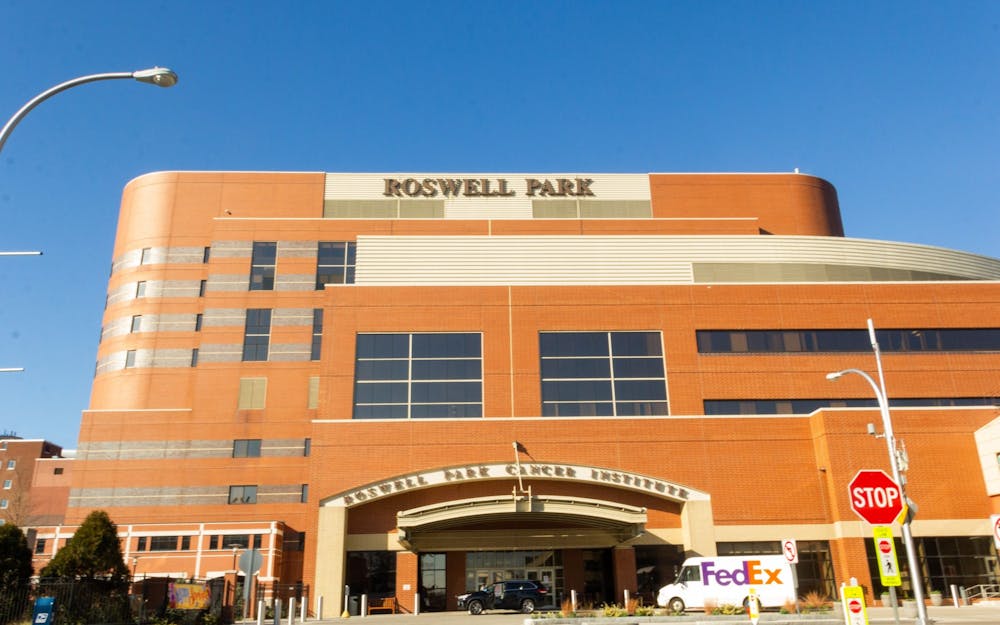The Food and Drug Administration gave UB and Roswell Park Comprehensive Cancer Center permission Wednesday to begin a “collaborative clinical study” using an experimental drug, sarilumab, to try to treat some COVID-19 effects.
Igor Puzanov, the trial’s co-principal investigator, hopes the drug, which reduces inflammation, may alleviate some of COVID-19’s worst symptoms like lung injury.
The study is one of the ways UB is contributing to COVID-19 relief efforts, along with the university’s donation of resources to help increase local testing. Erie County has 639 active coronavirus patients, 141 recoveries and 22 deaths, as of Saturday at 11 a.m., but the Jacobs School of Medicine and Biomedical Sciences’ Chief of Infectious Disease Thomas Russo said the amount of non-reported cases is “likely ten-fold greater” and Buffalo’s peak is “probably” two or three weeks away. Russo said local medical facilities can manage the amount of patients they have right now, but some healthcare workers think the Buffalo area may not be prepared for the influx of patients over the coming weeks.
The FDA study is part of a worldwide study that will “eventually” involve 400 patients, including four in Buffalo. UB and Roswell began the trial by administering the sarilumab treatment to one patient at Roswell on Wednesday, but the initial trial will involve three other patients: with one at each Buffalo General Medical Center, Erie County Medical Center and Millard Fillmore Suburban Hospital. Patients will be considered eligible if they are categorized as either “severely ill, critically ill or have multi-organ system dysfunction,” according to Gene Morse, co-principal investigator of the trial and a SUNY distinguished pharmacy professor.
“This strategy does not treat COVID-19; it’s designed to address some of its most damaging effects, caused by inflammation and cytokine storm,” Puzanov said. “If it is proven effective in reducing or preventing severe lung injury in these patients, it could significantly reduce the need for ventilators.”
Morse said outcomes of the trial could come “within a couple of months” and that if it works Roswell and UB could eventually test up to 400 patients.
Hospitals hurried to comply with NYS’ order to submit plans to increase their critical care bed and intensive care unit bed capacity by 50% last week. Gov. Andrew Cuomo signed an executive order Friday mandating medical facilities in areas of NYS that aren’t yet overwhelmed by the COVID-19 pandemic to redistribute ventilators and other equipment to hospitals in areas with the most cases. Cuomo did not specify which hospitals would have to redistribute equipment. It is likely that equipment would be sent downstate, where New York City has 56,289 cases and 11,739 people hospitalized, according to NYC Health.
The Erie County Medical Center has 74 ventilators, 401 critical care beds and 53 intensive care beds after complying with NYS’ 50% capacity increase, according to ECMC’s Vice President of Communications and External Affairs Peter Cutler. ECMC has 19 positive COVID-19 patients, as of Wednesday, and 32 patients undergoing COVID-19 testing.

Roswell Park Cancer Institute, where the first patient in Buffalo received sarilumab treatment. UB donated materials needed for COVID-19 testing to Erie County.
Local healthcare workers urged President Donald Trump to use the Defense Protection Act to force companies to convert factories to make more ventilators, N95 respirators and other personal protective equipment at a rally on Thursday. Two unions –– the Communications Workers of America and the New York State Nurses Association –– organized a rally at Niagara Square.
UB transferred two machines to Kaleida Health Laboratories to “assist with the processing of COVID-19 tests,” according to a press release. UB also donated 250 nasopharyngeal swabs and six pints of molecular biology-grade ethanol –– two materials needed for COVID-19 testing –– to Erie County.
Russo said medical facilities in the Buffalo area have plenty of “critical resources,” like ventilators and intensive care unit beds, to care for the current amount of COVID-19 patients in Erie County. He said facilities are trying to expand capacity as those resources begin to be utilized, so it would be difficult to predict how many local cases would begin to “overwhelm” healthcare facilities.
Russo said that although the Buffalo area does not have access to “optimal” testing yet, he thinks that public health measures implemented on March 16 have been “effective” and have “flattened the curve” in the area. He said continuing social distancing is important to reduce the number of local cases so healthcare facilities don’t get overwhelmed.
Just over two weeks ago, businesses were open and people were out for St. Patrick’s Day, despite the first three confirmed cases of COVID-19 in Erie County reported on March 14 and Cuomos’ advice to avoid large groups.
Russo said people defying social distancing regulations “got us to where we’re at now.”
“I think [St. Patrick’s Day weekend] unquestionably increased the number of cases, and sort of hastened and got us to where we’re at now a little bit more quickly,” Russo said. “And, you know, variations of that behavior are ongoing.”
Julian Roberts-Grmela is a senior news editor and can be reached at julian.grmela@ubspectrum.com and on Twitter @GrmelaJulian.

Julian Roberts-Grmela is a senior news editor for The Spectrum and an English and philosophy major. His favorite book is “White Teeth” by Zadie Smith and he hopes that one day his writing will be as good as hers.





